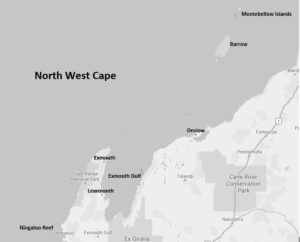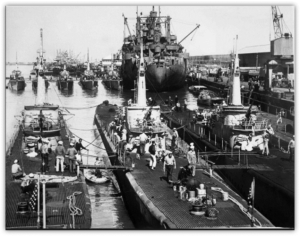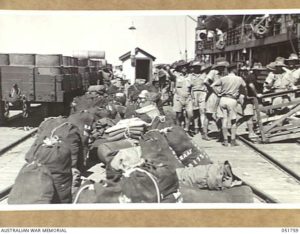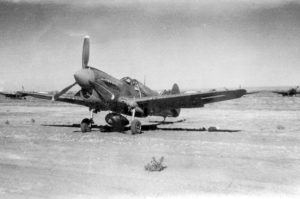- Author
- A.N. Other
- Subjects
- WWII operations, History - WW2
- Tags
-
- RAN Ships
- None noted.
- Publication
- December 2020 edition of the Naval Historical Review (all rights reserved)
By Colin Randall
Exmouth Gulf, Western Australia
In 1618, the Dutch East India Company ship Mauritius, under command of Willem Janszoon, landed near North West Cape and named Willem’s River, which was later renamed Ashburton River.
The first British vessel to visit these waters was the East Indiaman Tryall under command of John Brookes, who sighted the coast in 1622 before being wrecked on an uncharted reef off the Montebello Islands where 143 crew scrambled ashore. They took to two longboats and made for Batavia but only 40 survived. Tryall was Australia’s first known shipwreck, the actual wreck eluded searchers until its discovery in 1969.
Exmouth Gulf was named by Commander Phillip Parker King RN of HMS Mermaid when conducting hydrographic surveys in the area in 1818. The name honours Admiral Viscount Exmouth (1757-1833) a distinguished Royal Naval hero. The River Exe runs through the south-western English county of Devon.
An American presence in this remote region dates back to the 1790s when whalers operated here but there was no permanent presence on land. Norwegian Bay and Point Cloates were used for shore-based whaling from 1913 to 1957 when the whaling station was closed and transferred to Carnarvon. For three years only, between 1936 and 1938 whale factory ships with chasers operated off the northwest coast.
Inland areas around the North West Coast were not explored until 1837 and it was not until the 1860s that the land was opened up to cattle and sheep farming. Further north pearling became an important industry at Tien Sein, later renamed Cossack. Aboriginal people inhabited the region and remains of their rich cultural history are to be found. They were often displaced by European development with many of their descendants now located in Carnarvon to the south and Onslow to the north.

The region surrounding North West Cape and the entrance to Exmouth Gulf is unique as the continental shelf lies close to the land producing localised tidal currents with a large tidal range. This enhances biological activity attracting fish and other marine animals. Ningaloo Reef which lies off the coast extends for about 300 km south of the Cape.
Operation Potshot
In 1942, with the rapid advance of Japanese forces in the Philippines and the potential loss of Allied bases in the Netherlands East Indies, the US Navy moved submarine tenders US Ships Holland and Otus, together with 25 submarines, to Fremantle and Albany. Over the next three years, Fremantle became the largest submarine base operating against Japanese naval and commercial shipping. Along with Dutch submarines that fled south, and later British submarines, the mostly 130 US submarines ranged from Fremantle as far as the Japanese homeland where they took ‘Potshots’ at the Japanese.
An interim refueling stop was required to enable long-range submarines to reach operational areas off Japan. An initial proposal to refuel at Darwin was rejected in favour of creating a base in Exmouth Gulf. The creation of the protected refueling and maintenance facility was called Operation Potshot.
On 19 May 1942 the seaplane tender USS Childs and three Catalina aircraft left Albany for the Bay of Rest on the southern side of Exmouth Gulf, where an anchorage was established. Due to severe weather conditions in the Gulf, it subsequently proved impossible for submarines to be serviced and maintained alongside the submarine tender USS Pelias. The cyclone season in north western Australia extends from November to April with the town of Onslow being known as ‘Cyclone City’ owing to regular severe storms.
Apart from the refuelling of submarines and the Catalina seaplanes there was a land-based fighter plane squadron. In addition, land forces provided radar and anti-aircraft batteries. Yanrey, the airfield constructed for fighter aircraft, later became RAAF Base Learmonth. The town of Onslow 150 km away to the north east, with its deep-water jetty, provided a partial solution for fuelling and provisioning of the submarines. The Commando Z Special Unit used Potshot as a staging post for Operation Jaywick, the raid on Japanese shipping in Singapore Harbour, in September 1943. On 19 October 1943, the ship and raiding party arrived safely back at Exmouth Gulf.

Exmouth Gulf was bombed by Japanese ‘Betty’ aircraft on several occasions. After two Japanese raids on 20 and 21 May 1943, the US Navy decided to abandon the submarine base at Exmouth Gulf, and moved down to Fremantle until 1945. The base was also struck by a tropical cyclone, which hit the coast during that time frame and damaged the facility. The RAAF maintained their airfield at Yanrey after the US Navy departed the area.
Operation Potshot was wound up in 1945 as the US forces took back the Philippines and submarine operations were moved north. Nearly all vestiges of the Potshot jetty and the land-based facilities including the camp have, over the years, disappeared as cyclones periodically ravaged the area.
As RAAF Base Learmonth, the airstrip lives on as one of the main forward bases of the RAAF. North of the airstrip, on the tip of the North West Cape is the Naval Communication Station Harold E Holt. This station provides communication with US Navy and RAN ships and submarines. The town of Exmouth provides housing for personnel of the current facilities and accommodates a booming tourist trade.
Onslow – Cyclone City
Onslow was actively involved in WWII with all three Australian services being present at one time or another from 1942 until the end of the war in 1945. RAAF 76 Squadron was based at the Onslow airstrip for a short time. Key features of the town were the jetty and the airstrip. Onslow became the furthest south town to be bombed by the Japanese when on the night of 15 May 1943 a solo plane, based at Surabaya, dropped three bombs on the airstrip with no casualties or damage to aircraft.
The Navy was involved in unloading marine diesel from tankers at the jetty, pumping to the onshore tanks and the subsequent transfer of fuel into a lighter, for refuelling submarines, and furnace fuel oil (FFO) for surface ships. Four fuel storage tanks were constructed in 1942/1943, one for diesel, one for aviation fuel and two for FFO. Aviation fuel was moved to Potshot in barrels. The Australian Army provided logistics and artillery support. In later years the RAN also used Onslow as a base to assist in British military nuclear weapons tests, the first conducted on the nearby Montebello Islands in 1952 and two more in 1956.
Wartime Facilities
The jetty of some 2,460 ft in length was originally constructed to cater for the State Shipping Service ships and the Blue Funnel Line that plied to Singapore. Following silting of the Ashburton River and difficulty with jetties east of the mouth of this river, a reinforced concrete jetty 2,162 ft long with a Tee-head 300 ft long was built at Beadon Point in 1923, providing 22 ft of water at low tide. After serious damage by a cyclone in 1934, the outer end was rebuilt in timber to give a total length of 2,993 ft. Imports included all provisions, building equipment, timber and general merchandise, and exports involved wool, pearl shell and minerals.
Since the 1920s, planes have been flying into Onslow. Over that time, Onslow aerodrome has changed locations, been the target of bombing raids and been submerged under water from cyclonic storms. The existing airfield was upgraded in early 1942 to support fighter and bomber aircraft. The main military presence in the vicinity of Onslow however was centered on the operations and supporting activities at the Onslow airfield. The original March 1942 contingent of approximately 30 personnel, comprising 18 soldiers of the 11th Volunteer Defence Corps (VDC) and RAAF personnel at the airfield operating GLII radar was increased in early March 1943 with the arrival of 7 Battery, 2/3 LAA Regiment using 3-inch and 3.7 inch anti-aircraft batteries plus Bofors guns to defend the newly constructed fuel tanks, airfield and the RAAF fighter and torpedo-bomber squadrons which had commenced operations there.
Wing Commander Forsythe from North West Area Headquarters visited Onslow on 7 February 1943. Due to a lack of sufficient fresh water the Squadron was ordered to relocate to Potshot airfield on the other side of Exmouth Gulf. Quonset huts were provided for accommodation and support facilities.
Fuel Storage Tanks
In order to supply the Potshot base with marine fuel oil, marine distillate and aviation fuel, four 2,000 ton welded steel tanks were constructed at the port of Onslow. The tank for distillate for the submarines was in service mid-1943. The aviation fuel tank was to supply filled drums for use at the RAAF facilities at Exmouth, Yanrey and Onslow. It may also have provided drums of fuel for the secret air base at Corunna Downs, near Marble Bar. The latter would have been transhipped to Port Hedland and sent out on the tramline which then existed between Port Hedland and Marble Bar. The tanker Ondina served as floating storage until the Onslow tanks were complete. A 550-ton lighter towed from Darwin was used to transfer marine distillate to the submarines while fuel oil was supplied to larger ships unable to berth alongside the jetty. Aviation fuel was supplied to the Catalinas. Fuel for the fighter aircraft at Potshot was transported in drums.
The lighter was 156 feet (48 m) in length, 14 feet (4.3 m) depth and 30 feet (9.1 m) breadth. The hull included 10 oil tanks, separated by air spaces and cofferdams, which held a capacity of 550 tons of liquid fuel oil. Sleeping accommodation and a saloon were also provided in the forward portion. Two sets of diesel engines with centrifugal pumps discharged the fuel oil from the tanks. Oil tankers were discharged at the jetty and fuel pumped to the specific designated tank, i.e. marine distillate, aviation fuel and fuel oil.
A PWD engineer, Ken Kelsall, who was sent to Onslow to supervise the construction of the tanks, states the task was completed in 1944. The work was carried out by Civil Construction Corps members employed under the Allied Works Council. The steel for the tanks had to be transported by sea from Perth, the lower section being plate of half inch thickness and thinning out to quarter inch plate at the higher levels. The cement, sand and metal for the tank bases and buildings was barged from Perth whilst the blast walls were of rammed earth construction using local clay/sand and gravel mixed with cement.

All tanks were set well down in the dunes, the two fuel oil tanks situated close to the shore with a large pumping station between them, whilst the distillate tank was further back and further inland again as was the aviation fuel tank.
On 15 September 1943, Onslow was bombed when high explosive and incendiary bombs were dropped, mostly in the vicinity of the airstrip which was closer in towards Onslow than the present-day airfield. It is of interest that this incident did not even warrant a mention in the 3rd Australian Corps War Diaries of that date even though from time to time sightings of unidentified aircraft over Derby and Wyndham appeared to justify recording.
Following this raid, the US Navy provided a number of AA weapons to protect the tank area, which remained there until November 1944. Prior to this, during the operation of the Potshot base, the 2/3rd Australian LAA Regiment provided a battery of 40 mm Bofors guns at Onslow. Primarily they were situated to protect the fighter airstrip.
At the end of WWII, the Shell Company of Australia took over the operation of the fuel depot which supplied fuel to the State Shipping Service, the Blue Funnel Line vessels Charon and Gorgon and naval units involved in the atomic tests at Barrow Island. In 1961 a cyclone destroyed a 300 m section of the jetty and the government decided against rebuilding the jetty.
Many of the facilities still exist today. The marine diesel tank was cleaned out and is used for the town water storage and the aviation gasoline tank is used for storage and as a cyclone shelter. The northernmost fuel oil tank is used for storage and the remaining fuel oil tank still contains the fuel oil left in it after the recovery programme ceased.
After the war the Cape region reverted to its traditional quiet fishing and pastoral endeavours. In 1953 Western Australian Petroleum acquired the remaining defence buildings and started oil exploration, and from the 1960s prawn trawling and pearl culture started to flourish.
RAAF 76 Squadron
The squadron aircraft moved to Strauss Field, Northern Territory, via Batchelor on 9 October 1942, and convoy patrols and escort duties were carried out. Personnel disembarked at Darwin on 5 October. On 21 January 1943 four P-40 Kittyhawks made a head-on night attack on three Japanese ‘Betty’ bombers in which one of the enemy aircraft was shot down. In February 1943 operational training and seaward and coastal patrols were conducted from Onslow.
MV Maetsuyker arrived at Onslow on the afternoon of 4 February 1943. Ten of the Squadron aircraft which had been providing escort duty for the ship arrived at Onslow at the same time. The aircraft had operated out of Drysdale River Mission on the second day after the departure of Maetsuyker from Darwin. The escort patrols on the 3rd and 4th days were carried out from Derby. Unloading of Maetsuyker commenced early in the morning of 5 February 1943. As nothing had been prepared for their arrival all personnel were billeted on the ship until tents had been unloaded to set up a camp on the outskirts of Onslow. The ship was fully unloaded by the afternoon of 6 February 1943.

Maetsuyker and its escorts were recalled and loading commenced on 9 February 1943. The ship sailed at 6 am on 12 February 1943 and arrived at Potshot at 3 pm the same day. They started to unload on to barges but work stopped at 10 pm as a cyclone was approaching. Personnel going ashore on the last barge that night lost all of their kit and had to eventually swim ashore. The impact of the cyclone lasted until 16 February 1943. They started unloading the ship again but this time they had to use the ship’s lifeboats as the barges had all been beached during the cyclone. They finished unloading the ship on 17 February 1943.
RAAF Learmonth
In late 1942, the US Navy asked the Australian Government for permission to build an airfield near the future submarine base at Exmouth Gulf. The site for the airfield was selected at Yanrey, 20 miles south of Exmouth. The site was later to be named Learmonth Airfield. While the airfield was being constructed, 76 Squadron RAAF moved to nearby Onslow in February, 1943, and then to Exmouth Gulf in March, 1943. In April 1943 76 Squadron was ordered back to Bankstown.
This airfield has an asphalt/concrete main runway 3,047 metres long together with associated taxiways and aircraft hardstands. RAAF Learmonth can support all RAAF aircraft operating at full loads. This airfield also offers regular commercial flights to Perth and north to Karratha and other destinations. The RAAF also operates an 18,954-hectare Air Weapons Range some 30 km southwest of the air base.
The airstrip at Learmonth is so long and wide it can handle any size aircraft. Learmonth was named after Wing Commander Charles C. Learmonth, who was the Commanding Officer of No. 22 Squadron (Bostons), RAAF, based at Vivigani Airfield, Goodenough Island (PNG). He was later appointed Commanding Officer of No. 14 Squadron at Pearce. He was killed during a training flight accident off Rottnest Island on January 6 1944. RAAF Learmonth is one of the RAAF’s three ‘bare bases.’ No RAAF units are currently based at Learmonth.
The ‘Bare Bases’ are well provisioned with bunkers and other defensive facilities and have the capability to support the RAAF’s F/A-18 Hornets and F-111 aircraft during wartime. During peacetime the Bare Bases are maintained by a small caretaker staff. Flying and support units are not permanently stationed at Bare Bases. The bases are, however, regularly activated during exercises with flying and support units deploying from other RAAF bases to staff the base for the duration of the exercise.
NAVCOMMSTA Harold E Holt
In the early 1960s with the operation of US nuclear submarines in the Indian Ocean and further north there was a need for secure VLF communication. The lease for what became US Naval Communication Station North West Cape was negotiated in 1963.
The present day town of Exmouth is located on the tip of the North West Cape. The town is 1,270 km (789 miles) north of Perth and 3,366 km (2,092 miles) southwest of Darwin. Not established until 1967, the town was built to house the families of the US naval personnel. When the station commissioned on 16 September 1967 there were more than 800 people at the facility: 480 USN personnel and 19 US civilians, the remaining 300 or so were Australian civilians. Following the death of Prime Minister Holt three months later the station was renamed US Naval Communication Station Harold E Holt. In 1972 Harold E Holt became a joint facility known as NAVCOMMSTA, with an RAN officer as second in command, and 35 RAN personnel integrated into the general operations.

Beginning in the late 1970s, the town began hosting US Air Force personnel assigned to Learmonth Solar Observatory, a defence science facility jointly operated with Australia. In 1991 it became Australian Naval Communication Station HMAS Harold E Holt. Eventually in 1993 all USN personnel were withdrawn. In December 2002 the RAN handed over operation to the Defence Materiel Organisation. The base is currently operational under contract by Raytheon Australia. In October 2020 it was announced that Government approval had been given to upgrade the joint US-Australian Space Surveillance facility at Harold E Holt
The station provides very low frequency (VLF) radio transmission to US Navy and RAN ships and submarines in the western Pacific Ocean and the eastern Indian Ocean. It is reportedly the most powerful transmission station in the southern hemisphere having a transmission power of 1 megawatt. The station has thirteen radio towers extending to 389 m in height, the tallest structures in Australia. The antenna network was designed to withstand winds of over 500 km per hour, well beyond the peak of tropical cyclones experienced in this location.
Present day at North West Cape
The current regional economy is based on tourism, fishing, mining, horticulture and livestock. Offshore oil and gas reserves are also being exploited. Such features as the Ningaloo Marine Park draw international visitors and the region appears destined for a significant increase in tourist numbers both from home and overseas as an attractive and relatively unexploited destination. Pre-COVID, cruise ships were beginning to visit Exmouth Gulf.
References:
Cairns, L., Secret Fleets: Fremantle’s World War II Submarine Base, 2011. West Australian Museum.
Glyde, Bob, The Secret Potshot (Exmouth) Base – The Onslow Fuel Tanks, Journal of the Royal Australian Artillery, Historical Society of Western Australia, Edition 2, June 2005.
Humphreys, Brian, Calls to the Deep – The History of Naval Communication Station Harold E Holt, Exmouth, Western Australia, Defence Publishing Service, Canberra, 2006.
Morris, Michael R., US Navy High Frequency Direction Finding Sites during WWI & WWII, CTO Sea Dogs Database,Waldorf, MD, Updated 01 June 2008.




